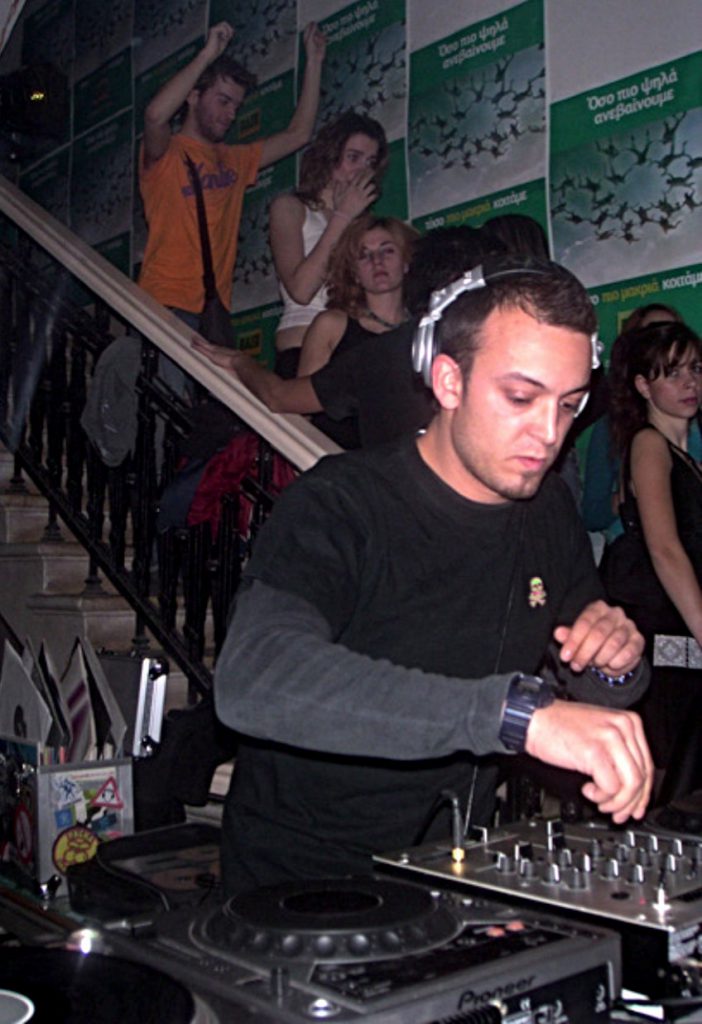We talked to Paul Gilmore aka Paul Pastourmatzis, photographer, designer, producer and head of instrumental hip hop label Pueblo Vista. Enjoy!

BEATOSCOPE: Paul, thank you for taking the time to talk to us today. Please introduce yourself to everyone that might not know you.
Paul: I’m a 38 years “old” guy who lives in the Alps but originally comes from sunny Greece. During day time I am a UX / UI Designer and at night an audio & visual content creator & curator.
BEATOSCOPE: What made you get into music? What kind of music did you listen to growing up?
Paul: What got me into music was definitely my dad. He also used to play the guitar, but before I got old enough he sold all of his gear to focus on work and family. It was the 80s… I grew up listening to Deep Purple, Led Zeppelin, Jimi Hendrix, Iron Butterfly… you get the picture. Then during my adolescent years this evolved (naturally) to heavy metal. Metallica, Pantera, Sepultura, Obituary, Blind Guardian, Iced Earth to mention a few…
From my mother’s side, I got the more disco-ey influences… ABBA, Earth Wind & Fire, Diana Ross etc… Also Michael Jackson was a big thing in our house. I would run around as a kid and sing “Billie Jean”

BEATOSCOPE: Did you start playing guitar and joined a band?
Paul: Nah, never played guitar. I only know the starting notes of “Enter Sandman” and “Nothing Else Matters” from Metallica. I did play drums for a while after highschool and did some vocals for a Sepultura tribute band.
BEATOSCOPE: That must have been a fun time I imagine. At what point did you decide to start a label?
Paul: Definitely some fun times there… and a lot of soar throat and tea drinking lol. That’s a question that requires a long reply.
The decision to start Pueblo Vista was back in 2014. I wanted to create a YouTube channel to host my travel videography and vlogs (the cringe) and also music I liked listening to when I was at the office. I’m one of these old-school guys who used YouTube for music. That got me into the whole copyright subject (that I heavily invested after that). One thing led to another and I started using these chill hip hop beats for my videos, because they were copyright free. Not because of monetization, because of imminent shut-down. My channel fended off at least 10 copyright strikes.
About 4 years later and specifically in January of 2018, I decided to venture into the whole collective / releasing / streaming thing. Pueblo Vista had gained plenty of traction, and that’s when ⟪ π ṽ ş ⟫ came into play. The audio entity of Pueblo Vista. So after a lot of thinking and planning of that same summer and during the Christmas and New Year holidays, I went into the offensive and started reaching out to artists I really liked. One correction tho, even though we do everything that a music label does, I personally don’t like that term. I see us more of a creative label and a streaming collective.

BEATOSCOPE: So in the process of choosing and looking for artists and spending a lot of time on it, did your criteria change the way you select beats?
Paul: Oh for real. Curating is definitely similar to producing. The more you do, the more you evolve, the more you can identify potential from one hit wonders, the more everything. I can’t be modest about it, but I have a good ear when it comes to music. Must be related to my early years as a DJ or whatever…
BEATOSCOPE: You’ve been a DJ, too? Please tell us about it.
Paul: Hahahaha… dear lord. Here we go. Yeah, I started mixing in 1996. I say mixing because it’s light-years away with just putting one record after the other (pretty much what you hear in all the Lofi Hip Hop Mixtapes lol – including ours). A friend of mine taught me how to do that. DJ Giorgio aka George is about 10 years older than me and he took me under his wing as a student because I was fascinated to see him how he was mixing deep jazzy house using two turntables. Soon after a couple of years mixing jazz house and being a fanboy of Kevin Yost, I left for the UK to study computer science. In the UK I was introduced to more (proper) house and progressive trance – or what I liked to call “Paul Oakenfold Music”.
Long story short I DJ’d for about 10 years, then realized that in order to spin to bars and clubs you had to kiss ass really hard and shifted my interest in music production.

BEATOSCOPE: Wow you went from prog rock to metal to jazz and house. That’s an impressive variety. If you look at all those different genres, is there something they have in common to you?
Paul: Rhythm basically. I’m a rhythm guy. If I nod my head, it’s good and if it can make me hum the melody, I’m sold. In my case and since you mentioned the transition, I simply get softer with every year. The BPMs kinda dropped.
BEATOSCOPE: So when you got into instrumental hip hop how did you find artists at first? And how do you do it today?
Paul: Dude, I can’t reveal the secrets of the trade. Hahahahaha. Joking. Like everyone else I guess. A lot of soundcloud and bandcamp digging. Through Spotify & Apple Music recommendations. Other people’s recommendations, recommendations from listeners (you’d be surprised how many)… Nowadays a lot come in form of submissions too, since we love working with young upcoming artists and I guess the word gets around in the community.

BEATOSCOPE: Many upcoming artists work hard trying to get heard. What advice would you give them?
Paul: I won’t say “Don’t give up”, that’s a bit cliche. Plus one has to know when to stop. I’d say to have realistic goals and try to achieve them. Last August I would have stopped « π v ś » if I didn’t reach certain goals. Lemme illustrate this with an example. In March of 2018 we had our first release. The goal was to get on the algorithms good graces and hit certain numbers in terms of streams and listeners. And I set a goal. 50-100K streams across all releases in one year. Of course we blew past that goal almost 6months after. However, I’ve always set realistic milestones like that. Based always on numbers and trends. Pro tip: know your analytics boys and girls. I spend so many hours in there to figure out trends and demographics etc…
BEATOSCOPE: Congratulations on reaching your goal and on the succes. On spotify you currently have more than a million monthly listeners. How do you feel about spotify and the change playlists brought to the game?
Paul: Thank you! Numbers can really be helpful sometimes. Especially in setting goals. Yeah, we did the million monthly listeners. Everybody’s pretty happy about that and it’s something that came with the collaborative effort of everybody on the crew. How I feel about Spotify and the changes? Ufff, that’s a tough one. They say you don’t bite the hand that feeds you (hahahah). I definitely believe that the localized and global playlists have proven to be very useful in bringing audiences (new and existing) more and more new music. However, we mustn’t forget that we live in a day and age of automation and speed. Some people like playlists, others hate them. I personally believe that they’ve been a great help, exposing more and more artists and their music.
Nevertheless, where there’s human involvement, things do tend to become a bit more “interesting”. Public data are showing specific tendencies as well as preferences and in some cases nepotism. Do I disapprove this? Yes. Would I lose my sleep over it? No. That’s the industry whether we like it or not. However, our genre (instrumental hip hop etc) is only a small piece of the whole pie. We’re not in the major league nor A-List celebrities. It’s all about the community and supporting each other. Then and only then the changes brought by the playlists and the algorithm will truly benefit all of us. Not in terms of money and fame, but in terms of exposing the beats and the community.

BEATOSCOPE: This a major shift in terms of power. A placement on an editorial playlist can make or break an artist. Spotify is dominating this game. What should musicians demand to improve the situation?
Paul: Yes and no. The vast majority of artists live in broken state then – referring to your “break or make”. Spotify definitely is the pioneer of this game. No argument there. The shift of power (as well as dynamics) can easily be witnessed if someone keeps track of the “players” in any playlist. One good place to do that is chartmetric.com Unless you’re signed with a major label (and by major I mean SONY, Universal, Warner) you can’t really demand anything… You need to stay focused and not care about playlist placement. Playlists are not everything. Sure, they can be helpful but there’s a gazilion other things that need to be done before that happens. You need to start with the basics and invest time. Time to improve your craft. Time to cultivate your fan base, time to embed with the community, time to hang out with your family and friends (because we’re humans not machines).
BEATOSCOPE: As streaming services got more popular good old tapes and vinyl came back from the dead. Especially the instrumental hip hop genre loves releasing the analog way. How do you feel about that as a music fan and as a content creator?
Paul: I love vinyl. For me vinyl is king and I value it more than cassette tapes. Sorry but that’s my opinion and I’ve been pretty open about it. For me tapes are a gimmick but deffo great memorabilia. I’d be more excited if Mini-Discs made it back into the mainstream. LOL. However the real issue with both is purchasing it. In other words, supporting analog releases. There’s so much music released on the streaming platforms these days and it’s relatively more easy to make tapes or vinyl nowadays than 20-30 years ago. How many people are going to support it tho? I think we’re still in “beta” when it comes to analohg in this genre. There are some labels that sell vinyls hard; Chillhop Records. However you have to have a very strong and loyal fanbase (both audience and producers) to sustain that. And that’s coming from a guy who put out his first project on Qrates almost 2 weeks ago. We need 48 more copies to crowdfund…

BEATOSCOPE: We wish you the best of luck with this. Hopefully there will be more in the future. Now the first of my last two questions: what is a terrible way to promote music?
Paul: Thanks bruh! Cold-calling aka sending 1.000.000 e-mails and soundcloud messages with a copy and paste text. Leaving comments under YouTube videos “Hey bro, check my lofi beats”… Stuff like that… Oh, and my personal favorite: “I don’t want to spam the group, but…” 😀
BEATOSCOPE: Last one: what’s a great way to promote music?
Paul: Word of mouth. Let the music speak for it self. Tell your friends and then ask them to tell their friends. Get your family in the game. You’d be surprised to know that 25% of our audience is between the ages of 40-60+. Hotels, spas, restaurants, clothing stores, bars, hipster cafés. Reach out to them. Most businesses today have playlists as their daily soundtracks. Maybe you know someone who works in one of those places. Don’t pay money for promotion, unless you work with a legitimate promotion / marketing agency. Remember it’s not about the streams, it’s about engagement and sustainability.
BEATOSCOPE: Dear Paul, thank you so much for your time and patience throughout this lengthy chat. The final words are yours. Please let our readers know what you got cooking.
Paul: Risotto with mushrooms for the wife and me and later on warming up some milk for our little one. Hahahahaha. Aside from the pragmatic meaning of cooking, we got a winter compilation compilation coming up and also an interesting switchup in our sound. I can’t say more though…
Check out Paul’s links:
YouTube: https://www.youtube.com/channel/UCAY1RAyd8HeQGKFLHIKxZww
Spotify: https://open.spotify.com/artist/1p03eo7FG5sXEMs3lGFEwb?si=zC3srMhfTx6n0xP2xFsRrg
Apple Music: https://music.apple.com/us/artist/pueblo-vista/1414493728
Bandcamp: https://pueblovista.bandcamp.com/
Facebook: https://www.facebook.com/paulgilmore1981/
Instagram: https://www.instagram.com/paul_gilmore/?hl=de
Photography: https://unsplash.com/@paulgilmore_






